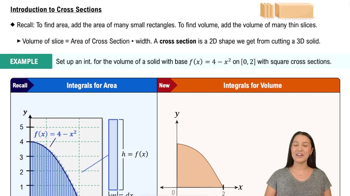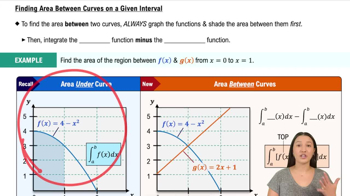A solid has a circular base; cross sections perpendicular to the base are squares. What method should be used to find the volume of the solid?
Table of contents
- 0. Functions7h 52m
- Introduction to Functions16m
- Piecewise Functions10m
- Properties of Functions9m
- Common Functions1h 8m
- Transformations5m
- Combining Functions27m
- Exponent rules32m
- Exponential Functions28m
- Logarithmic Functions24m
- Properties of Logarithms34m
- Exponential & Logarithmic Equations35m
- Introduction to Trigonometric Functions38m
- Graphs of Trigonometric Functions44m
- Trigonometric Identities47m
- Inverse Trigonometric Functions48m
- 1. Limits and Continuity2h 2m
- 2. Intro to Derivatives1h 33m
- 3. Techniques of Differentiation3h 18m
- 4. Applications of Derivatives2h 38m
- 5. Graphical Applications of Derivatives6h 2m
- 6. Derivatives of Inverse, Exponential, & Logarithmic Functions2h 37m
- 7. Antiderivatives & Indefinite Integrals1h 26m
- 8. Definite Integrals4h 44m
- 9. Graphical Applications of Integrals2h 27m
- 10. Physics Applications of Integrals 3h 16m
- 11. Integrals of Inverse, Exponential, & Logarithmic Functions2h 34m
- 12. Techniques of Integration7h 39m
- 13. Intro to Differential Equations2h 55m
- 14. Sequences & Series5h 36m
- 15. Power Series2h 19m
- 16. Parametric Equations & Polar Coordinates7h 58m
9. Graphical Applications of Integrals
Introduction to Volume & Disk Method
Problem 6.3.6b
Textbook Question
Let R be the region bounded by the curve y=cos^−1x and the x-axis on [0, 1]. A solid of revolution is obtained by revolving R about the y-axis (see figures).
b. Find an expression for the area A(y) of a cross section of the solid at a point y in [0,π/2].
 Verified step by step guidance
Verified step by step guidance1
Identify the region R bounded by the curve $y = \cos^{-1} x$ and the x-axis on the interval $[0,1]$. Since $y = \cos^{-1} x$, we can rewrite this as $x = \cos y$ for $y$ in $[0, \frac{\pi}{2}]$ because $\cos^{-1} x$ maps $[0,1]$ to $[0, \frac{\pi}{2}]$.
Understand that the solid is formed by revolving the region R about the y-axis. For a fixed $y$ in $[0, \frac{\pi}{2}]$, the cross section perpendicular to the y-axis is a circle.
Determine the radius of the cross-sectional circle at height $y$. Since the solid is revolved around the y-axis, the radius is the horizontal distance from the y-axis to the curve, which is $x = \cos y$.
Write the formula for the area $A(y)$ of the cross section at height $y$. The area of a circle is $\pi$ times the radius squared, so $A(y) = \pi (\cos y)^2$.
Express the final formula for the cross-sectional area as $A(y) = \pi \cos^2 y$ for $y$ in $[0, \frac{\pi}{2}]$.
 Verified video answer for a similar problem:
Verified video answer for a similar problem:This video solution was recommended by our tutors as helpful for the problem above
Video duration:
3mPlay a video:
Was this helpful?
Key Concepts
Here are the essential concepts you must grasp in order to answer the question correctly.
Inverse Trigonometric Functions
The function y = cos⁻¹(x) is the inverse cosine function, which maps values from [0,1] to angles in [0, π/2]. Understanding its domain and range is essential to relate x and y coordinates and to express x as a function of y when analyzing the region and cross sections.
Recommended video:

Derivatives of Other Inverse Trigonometric Functions
Cross-Sectional Area of a Solid of Revolution
A cross section perpendicular to the axis of revolution is a shape whose area depends on the distance from the axis. For revolution about the y-axis, the cross section at height y is typically a disk or washer, and its area A(y) can be found using the radius determined by the x-values corresponding to y.
Recommended video:

Introduction to Cross Sections
Relationship Between x and y in the Region
Since y = cos⁻¹(x), we can rewrite x in terms of y as x = cos(y). This relationship allows us to express the radius of the cross section at height y, which is crucial for setting up the area formula A(y) for the solid's cross section.
Recommended video:

Finding Area Between Curves on a Given Interval

 5:38m
5:38mWatch next
Master Introduction to Cross Sections with a bite sized video explanation from Patrick
Start learningRelated Videos
Related Practice
Textbook Question
